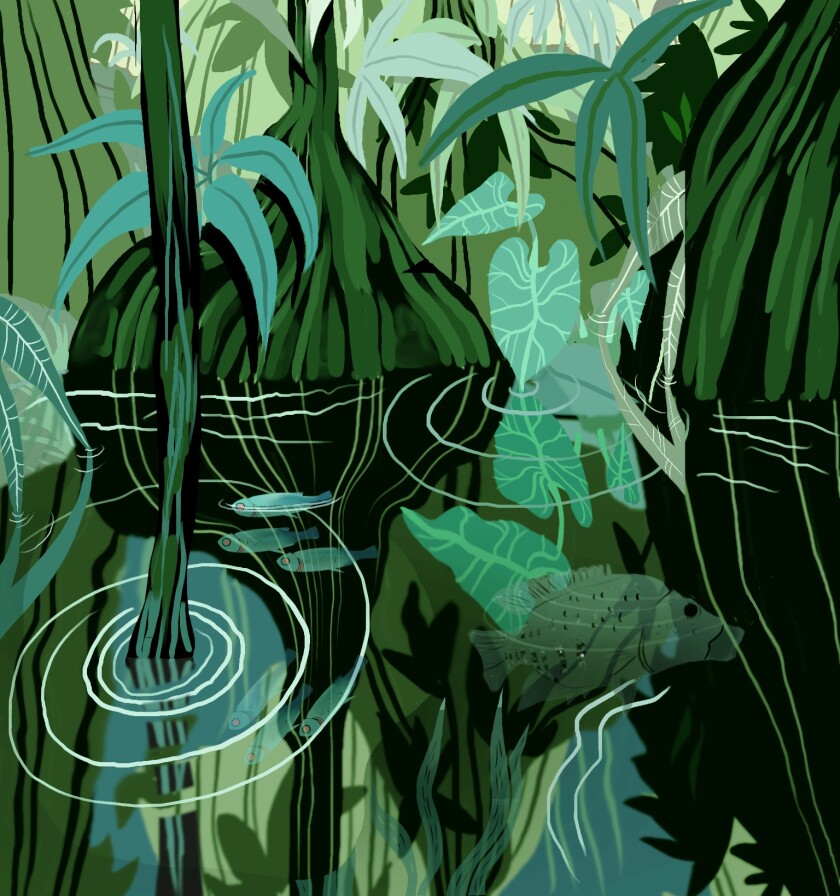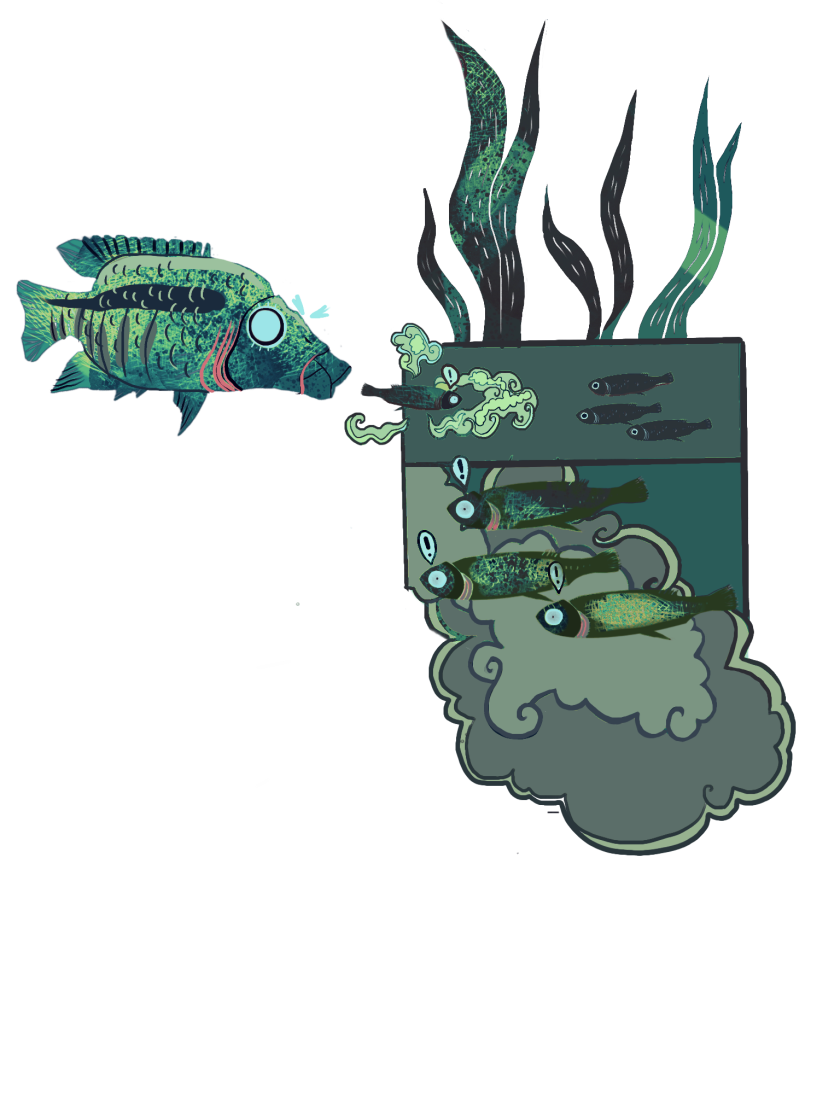The global prevalence of anxiety has increased in recent years, especially in response to the COVID-19 pandemic. Fish may help us understand human anxiety, social connection, and how to move forward.

“Fish can teach us a lot,” says Alli Duffy, a recently graduated biology PhD student and a member of the Johnson Lab of evolutionary biology. Duffy’s research focused on behavioral ecology—specifically, how fish behave and interact with their environment. In the wild, fish rely on environmental cues to navigate, survive, and reproduce. Duffy’s research shows that a fish’s evolutionary history and environment influence how it responds to these cues. The results of this research could ultimately teach us about human behavior.
“We share a lot of the same instincts, behaviors, and sensory systems with fish,” says Jerry Johnson, BYU professor of evolutionary biology and ecology and director of the Johnson Lab. “We can learn a lot about ourselves when we study fish and frogs.”
Costa Rican Fish Evolution
Brachyrhaphis rhabdophora (B. rhabdophora) is a unique species of small Costa Rican fish that resembles pet store guppies. These fish are known locally as olominas (similar to minnows) and exist in Costa Rica’s geographically isolated streams. The olominas’ environment is ideal for studying biological diversity and how that diversity arises in response to different environmental pressures—the Johnson Lab’s specialty. The lab focuses on understanding evolutionary diversification in the wild and what it can tell us about patterns of life on earth today.

Duffy’s previous research showed that fish respond directly to chemical cues related to danger. For example, when a fish is attacked or killed by a predator, its skin often releases chemicals that signal danger to its peers, who can then modify their behavior to avoid a similar fate. When exposed to these alarm cues, fish go on high alert. They move more cautiously, swim closer together, and occasionally jump out of their tanks—all behaviors that can be quantified.
Duffy wanted to know if this warning information could also be transmitted indirectly through social cues (as opposed to direct transmission via exposure to a chemical cue) and whether a fish’s social response is dependent on its evolutionary history. In other words, were fish that evolved under stress (e.g., in the presence of predators) more likely to trust socially cued signs of danger from their peers?
To study this question, Duffy and her team traveled to Costa Rica to collect B. rhabdophora from two distinct populations—one that evolved in the presence of predation (high-risk) and one that evolved in an environment with little to no predation (low-risk).
Catching the Social Contagion
Back in the lab, the social experiments were set up such that a single fish (observer) was placed in a transparent tank next to a tank of three other fish (demonstrators). With this arrangement, observer and demonstrators could see each other without sharing the same water and so were chemically isolated from each other. The fish were then exposed to different treatments, and their anxiety responses were measured.

As expected, during the experiments in which both demonstrators and observers were exposed to the alarm cue, all the fish displayed anxious behavior. However, in the experiments where the demonstrators were exposed to the alarm cue but the observer was not, only the high-risk observers caught the “social contagion” and displayed anxiety.
Basically, the fish that evolved with predation trusted their peers’ anxious behavior and followed suit. The fish that evolved without predation, however, were more skeptical of their peers’ anxiety and remained calm.
“If you have a long history with predation, then you’re more sensitive to this contagion of fear, like you have a reason to be tuned into your friends’ behaviors,” Johnson explains. “But without predators, the fish have essentially lost their ability to worry about dangers that don’t exist.”
Johnson and Duffy both agree this might mean that holding onto the sensory and neural machinery responsible for triggering anxious behavior when the environment doesn’t require it may be costly. Johnson reflects, “When evolution sees a cost that can be removed over time, it does.”
Lessons for Humans: Social Buffering
Relating this to humans, we now live in a modern world that is largely stripped of impending threats to survival, like predation.
“Yet, countries that are presumably the most ‘comfortable’ have the highest levels of general anxiety,” says Johnson. “This research suggests that the increase in anxiety, despite the lack of imminent danger, might be evolutionarily costly to humans.”

In other words, survival fears and anxieties that were once essential for keeping our ancestors alive may actually be detrimental to human health now that predatory dangers (e.g., tigers trying to eat us) practically do not exist. There’s a mismatch between the environment and our behavioral responses (e.g., anxiety) that may contribute to additional harm from an increase in long-term anxiety levels with no evolutionary benefit.
Although this anxiety may be evolutionarily costly, Duffy’s research suggests that social connection lessens anxiety’s negative effects. In experiments where the observer fish was given an alarm cue but the demonstrators were not, both high- and low-risk observers displayed “social buffering,” or reduced anxiety, upon viewing their calm peers (although this effect was more pronounced in the low-risk group). Even though the observer directly sensed the chemical cue that danger was present, observing its peers’ calm behavior lessened its anxiety.
“Other minnow research has shown that fish can unlearn trauma responses through social learning,” says Duffy. “Placing fish that have previously learned something is unsafe with fish who view the stimulus as safe diminishes their fear response.
“If we see these patterns with these small, cognitively simple fish, it’s likely the pattern [of unlearning fear responses] is also preserved in humans.”
Indeed, human studies have shown that social connectedness is associated with less anxiety throughout life and with better health in general. Duffy’s research highlights the impact of social information on behavior and agrees with these human studies, which are relevant especially in the wake of the COVID-19 era when social distancing was prevalent. We, like fish, are affected by the people who surround us.
Duffy’s research is complete and is being prepared for research submission.